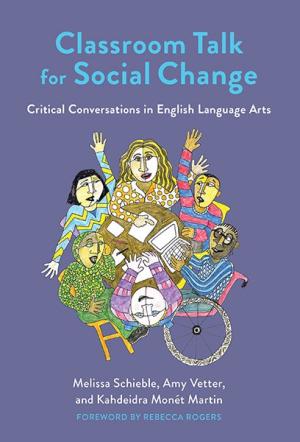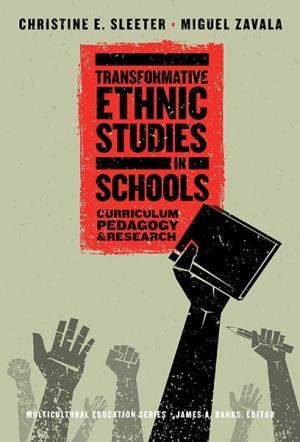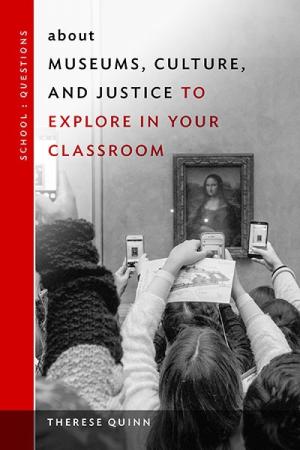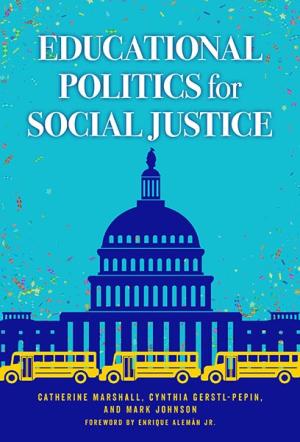Resources

Learn how to foster critical conversations in English language arts classrooms. This guide encourages teachers to engage students in noticing and discussing harmful discourses about race, gender, and other identities. The authors take readers through a framework that includes knowledge about power, a critical learner stance, critical pedagogies, critical talk moves, and vulnerability. The text features in-depth classroom examples from six secondary English language arts classrooms. Each chapter offers specific ways in which teachers can begin and sustain critical conversations with their students, including the creation of teacher inquiry groups that use transcript analysis as a learning tool. (From the Publisher)

This timely and compelling book conceptualizes Ethnic Studies not only as a vehicle to transform and revitalize the school curriculum but also as a way to reinvent teaching. Drawing on Sleeter’s research review on the impact of Ethnic Studies commissioned by the National Education Association (NEA), the authors show how the traditional curriculum’s Eurocentric view of the world affects diverse student populations. The text highlights several contemporary exemplars of curricula—from classroom level to district or state-wide—illustrating core concepts in Ethnic Studies across a variety of disciplines and grade levels. A final chapter considers how research on P–12 ethnic studies can be conceptualized and conducted in ways that further both advocacy and program sustainability. Transformative Ethnic Studies in Schools is essential reading for educators working to transform schools by rehumanizing learning spaces for all students. (From the Publisher)

Museums are public resources that can offer rich extensions to classroom educational experiences, from tours through botanical gardens to searching for family records in the archives of a local historical society. With clarity and a touch of humor, Quinn presents ideas and examples of ways that teachers can use museums to support student exploration while also teaching for social justice. Topics include disability and welcoming all bodies, celebrating queer people’s lives and histories, settler colonialism and decolonization, fair workplaces, Indigenous knowledge, and much more. This practical resource invites classroom teachers to rethink how and why they are bringing students to museums and suggests projects for creating rich museum-based learning opportunities across an array of subject areas. (From the Publisher)

Employing a social justice framework, this book provides educational leaders and practitioners with tools and strategies for grappling with the political fray of education politics. The framework offers ways to critique, challenge, and alter social, cultural, and political patterns in organizations and systems that perpetuate inequities. The authors focus on the processes through which educational politics is enacted, illustrating how inequitable power relations are embedded in our democratic systems. Readers will explore education politics at five focal points of power (micro, local/district, state, federal, and global). The text provides examples of how to “work the system” in ways that move toward greater justice and equity in schools. (From the Publisher)

Issues tied to race and culture continue to be a part of the landscape of America’s schools and classrooms. Given the rapid demographic transformation in the nation’s states, cities, counties, and schools, it is essential that all school personnel acquire the necessary knowledge, skills, and dispositions to talk, teach, and think across racial and cultural differences. The second edition of Howard’s bestseller has been updated to take a deeper look at how schools must be prepared to respond to disparate outcomes among students of color. Tyrone Howard draws on theoretical constructs tied to race and racism, culture, and opportunity gaps to address pressing issues stemming from the chronic inequalities that remain prevalent in many schools across the country. This time-honored text will help educators at all levels respond with greater conviction and clarity on how to create more equitable, inclusive, and democratic schools as sites for teaching and learning. (From the Publisher)

In the first blog of this series (“Nobody Goes to the Cinema to Read the Screenplay"), I noted that I’ve tried to boost my multimedia literacy by becoming a student of the cinema and seeking convergences between filmmaking and homiletics for the purposes of enlivening the preached word, communicating the gospel, and impacting hearers and their/our world. One of the most delightful ways of boosting cinema literacy is by attending film festivals and their accompanying “talks.” At a recent documentary film festival, I heard about “Impact Teams,” and knew immediately that this is one of those impactful (!) convergences between filmmaking and preaching. Preaching professors guide students toward paying careful attention to their hearers and identifying what impact their preaching might have on them. Noted homiletician Thomas Long encourages preachers to identify a one-sentence “function statement” for each sermon.[1] This statement identifies what a preacher wants the sermon to do to/for the hearers in light of what the biblical text does and in light of what is known about the hearers and their lives. In other words, the preacher identifies the hoped-for impact of the sermon on individual hearers, the church, and maybe even the world. Often the first weeks of introductory preaching courses are dedicated to helping novice preachers get to a faithful function statement in order to craft a sermon that will do what the preacher (with the guidance of the Holy Spirit, of course) hopes it will accomplish (e.g., inspire, comfort, challenge, motivate, encourage, etc.). A good place to begin is to help preachers identify the impact sermons have had on them. Because this task does not come easy (surprising as that might be), getting some distance from the discipline of homiletics altogether is often a helpful starting place. A Film’s Impact on the Viewer Have you ever wondered why the majority of people have a conversation with someone about the films they see and the majority of worshippers (so it seems) rarely talk about their worship experiences with another? Somehow, we’ve been culturally formed to identify a movie’s impact on us beyond “I liked it” or “I didn’t like it.” We’ve developed a sense that movies are supposed to affect us and in this age of expanding cinematic literacy we’ve gained the capacity to articulate such effects. The preaching classroom is served by taking the discussion one step further and exploring with students what created the impact, e.g. lighting creates mood, camera angle forces point of view, the pace of dialog might create a sense of immediacy. “The filmmaker organizes shots, camera movement, editing, and music to elicit certain reactions so that viewers will respond right on cue precisely as intended.”[2] Learning the techne of filmmaking points to the intentionality of a filmmaker seeking (unapologetically!) a hoped-for impact on the viewer. A Sermon’s Impact on the Hearer Grasping the cinematic intentionality of a filmmaker aids recognition of the homiletic intentionality of the preacher. What tools do preachers have to create mood or to adopt a point of view, for example? How can preachers choose and use these tools to accomplish the sermon’s hoped-for impact? Even beyond homiletical techne, students begin to develop an appreciation for the power of preaching. In other words, with some intentionality, sermons can do things. (It’s worth noting that intentionality can be Spirit-led and, therefore, need not be equated with manipulation as some have been led to believe.) Sermon Impact Teams While many preachers learn to embrace the need to identify their sermon’s hoped-for impact, far fewer preachers embrace the encouragement to find out what impact a sermon actually has had on their hearers. Preachers can learn from filmmakers in this regard as well. Not only do filmmakers work toward a desired impact, but they often have “impact teams” to find out how films affect their viewers. It doesn’t take blockbuster budgets for preachers to adopt sermon feedback practices in order to find out how their sermons are received by their hearers. • Consider soliciting responses to two or three written feedback questions posed on the back of the bulletin. • Designate one table at the coffee hour following worship as the sermon roundtable where members of the “sermon impact team” facilitate conversation. It is important to remember that this is not the occasion for the preacher to receive ego strokes or ego strikes. Instead, consider asking simply, “What happened to you during the sermon today?,” “What in particular made this experience happen for you?” With a bit of coaching, congregation members will soon embrace the power of the pulpit for their lives. What has been said about the screen can most certainly true about the pulpit: Movies change us. . . We can benefit, in other words, from an honest dialog with movies that probe the affairs of life, even unpleasant or disturbing events and conditions. And we become better critics with deeper self-awareness through spirited post-movie discussions that make us consider our values and refine our point of view, and even sometimes challenge us to think differently.[3] [1] Thomas G. Long, The Witness of Preaching, 3rd ed. (Louisville: Westminster John Knox Press, 2016), chapter 4. [2] William D. Romanowski, Cinematic Faith: A Christian Perspective on Movies and Meaning (Grand Rapids: Baker, 2019), 55. [3] As noted by Los Angeles film critic, Justin Chang. Romanowski, 26.
https://www.wabashcenter.wabash.edu/wabash-grants/project-grants/

One of the most common pedagogical errors I see in course syllabi is confusing a learning activity for a learning outcome. This often becomes evident when reviewing course learning objectives. A professor will write a course objective that reads "The student will participate in class discussions." Or, "The student will write a 12-page paper on an assigned topic." Or, "The student will submit two case studies from their ministry context." Those assignments provide clear expectations of student learning activities, but they reveal little about desired learning outcomes. What is the student supposed to learn as a result of doing those activities? Or, in what ways and to what extent will those activities provide evidence of student learning? The potential miss in confusing a learning activity for a learning outcome is that a teacher will be satisfied with grading an assignment, like a research paper, but fail to assess what learning (knowledge or skill) the student has acquired. A learning activity is something you want the students to do in order to achieve a learning outcome. A learning outcome is the evidence the student provides that they have understood a concept, gained knowledge, mastered a level of competence, or changed affect (attitude, appreciation, or opinion). This can be tricky in that sometimes an assignment can be the outcome. For example, in an English composition class writing an effective essay can be an outcome. But in a theology or philosophy course, writing an essay may be a learning activity that leads to an outcome. In the former, the teacher assesses the quality of the student assignment, like form, grammar, styles, etc. In the latter, the teacher assesses the essay for evidence of critical thinking, correct application of theological concepts, logical reasoning, avoiding errors of bias, sound interpretation, responsible use of facts, comprehensiveness, etc. Well-written Learning Objectives Can Help One way to overcome the trap of mistaking one thing for another is to design well-written learning objectives. Instead of identifying what a student will do ("The student will write a case study," "The student will read the text"), which is a learning activity, identify what the student will demonstrate ("The student will demonstrate . . .") which is a learning outcome. Avoid being satisfied with vague educational terminology like, "The student will understand . . ." without providing a criterion for what constitutes understanding. Use a taxonomy of learning to define the quality, characteristic, or criterion of understanding you will look for in your learning outcome (e.g., Wiggins and McTighe's taxonomy of understanding). Rubrics Can Help Another way to reveal the learning intent of an activity is by applying a learning assessment rubric. A well-written rubric will identify the criterion and the quality of learning outcomes. Some rubrics evaluate the product of a student assignment, but fail to identify the learning that is supposed to result from the assignment. Elegant rubrics can do both, but at least try to write your rubrics for outcomes of learning and not merely for evaluating a student product (an assignment). It can help to differentiate outcomes from activities by placing them in different headings in your course syllabus. Needless to say, your learning activities should align with your published learning outcomes: (1) In what ways will the learning activity help the student achieve the learning outcome (if it doesn't, then don't assign it), or (2) In what ways will the learning activity demonstrate that the student has achieved the learning outcome? Attached is a graphic handout that can help you differentiate an activity (assignment) from an outcome.

In 2015 my wife, Dr. Vanessa Watkins, took a trip with National Geographic to Cuba led by one of their photographers. One of the things I love about National Geographic trips is that the tour leader lectures in the hotel prior to going out to engage the culture. This leader lectured, but what blew my mind was that he never put a word on the screen. Throughout our fourteen-day trip, he always lectured with a computer, projector, screen, and images. Still images were his language of choice. He showed us what he was talking about and it was powerful. The images he shared were his images, he was a professional photographer, but that wasn’t what made the images work, it was his pedagogical decision to use the screen to project pictures. He would talk around the image; the image became the center piece of his comments and it worked amazingly well. Those images are still with me, five years later. What does this say to us as pedagogues? [caption id="" align="alignnone" width="2560"] Vanessa and Ralph Watkins in Cuba 2015[/caption] We have the big screen in our classrooms, in Moodle and Canvas, but how are we using this real estate? Are we using the screen to project words, words that we are re-reading to our students? Are we using the templates designed by engineers in Power Point who have no artistic or pedagogical training? Are we using the screen to show our students what we are talking about so that they can see it? I would suggest that we think about how we might use the screen as a pedagogical tool to show the students what we are talking about, to engage the creative centers of their brains, and to embrace the old saying, “a picture is worth a thousand words.” I would rephrase that old saying, “a picture saves us from saying a thousand words.”To use photographs in the powerful way they can be used, we have to understand why a photograph works. Better yet we have to learn to read photographs. Lets go to Cuba: This is my favorite image from Cuba. Why? This image is rich and full of information. When you read an image, you first read it from left to right. From left to right we see the juxtaposition of the old cars, a new car that is a taxi, a school bus with the backdrop of the capital. Smack dab in the middle of the image behind the newer black car is a street sweeper’s trash can. The image offers clarity, negative space (open space), and the beauty of Cuba’s sky. From the far-left bottom of the frame you see a blue car and that is put in conversation with the far-right of the frame where you see a white car. Sandwiched between these two cars is the complexity of Cuba. The capital stands as a monument under reconstruction; a symbol of Cuba’s determination to live, build, rebuild, reconstruct, and embrace its rich heritage of rugged survival. You also read an image from front to back. In the foreground we have this old blue car. The car’s headlights shine in the morning rising sun. You can vaguely make out the people in the car. The blue car greets you and it says, “Good morning Cuba!” As you move one layer back to the middle ground of the image, you see the black car, the street sweeper’s garbage can, the woman walking on the side of the school bus, the school bus, the capital, and the beautiful morning sky. The streets are clean and the streets speak of the beautiful blackness that is Cuba. This is an image that could be the opening for a lecture about my trip to Cuba. Why put words on the screen when I can put this picture on the screen? This picture takes you to Cuba. No words needed. This is an image you can talk around as you share with your students the complexity that is Cuba. When it comes to using images in our classes we need to use powerful images that tell stories and read well from left to right and from front to back. You are looking for images that speak to what you want to say, and say it in a way that brings to life the argument you are making. You have to ask what does this image say? What’s in the edges of the frame? Where does the eye go and where does it wander? What thousand words does this image say that I don’t need to say? Images speak if we look at them and listen. What are your images saying in your lectures? Here are some more pictures from my Cuba trip. I present them for your consideration to practice reading images. Start from left to right, then read the image from front to back, look at the edges of the frame and then ask, where does the eye go and what does this image say? [caption id="" align="aligncenter" width="1000"] Picture #1: The City View of Havana[/caption] [caption id="" align="aligncenter" width="1000"] Picture #2: The Fruit of Cuba[/caption] [caption id="" align="aligncenter" width="1000"] Picture #3: Walking and Talking[/caption] [caption id="" align="aligncenter" width="1000"] Picture #4: Time for Dinner[/caption] To view all my photos from Cuba: https://www.flickr.com/photos/ralphwatkins47/albums/72157652605129753

Recasting burnout as a crucial phase of service, Building Resilience Through Contemplative Practice uses real-world case studies to teach professionals and volunteers unique skills for cultivating resilience. Viewing service and burnout as interdependent throughout phases of stability, collapse, reorganization, and exploitation, the book uniquely combines elements of adaptive resilience theory with contemplative practices and pedagogies. Drawing on the author’s extensive experience working at the intersection of service and contemplative practices, this is the first book to demonstrate how and why professionals and volunteers can reframe burnout as an opportunity for resilience-building service. User-friendly case studies provide tools, skills, and exercises for reconstructive next steps. Chapters address personal, group, and structural levels of service and burnout. Illuminating the link between adaptive resilience and burnout as a normal and useful phase of service, Building Resilience Through Contemplative Practice is a necessary resource for professionals and volunteers across a wide range of service settings. (From the Publisher)